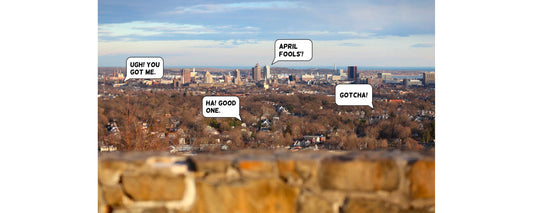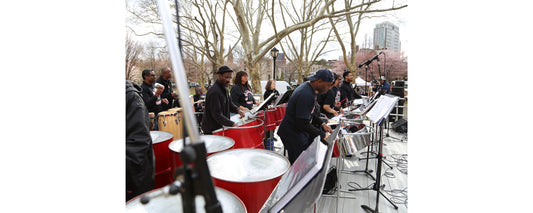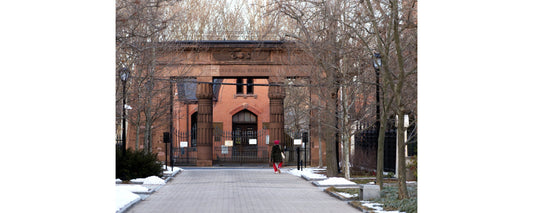Like a mountain piled with strata, a city as old as New Haven is layered with the remains of its past. Sometimes a layer lies in plain view but goes unnoticed by nearly everyone who passes by.
Such is the case with the pair of metal urns outside the New Haven Museum. The slender black figures, set atop low granite walls on opposite sides of the museum’s brick entry, rise like giant tulips growing from circular bases, casting their pistils high into the air. Leafy forms curve gracefully around like Elizabethan collars. In 1936, George Dudley Seymour, a local lawyer, civic reformer and historian, called them “undoubtedly the finest ironwork ever used in any New Haven house.”
sponsored by
The decorative urns—they can’t hold anything due to their open design—have seen events and eras come and go, dating to circa 1815. Conservator Susan Holbrook of Bethany, who restored them in 2018 with her husband, Mark Hawes, says they’re “fine-quality” examples of wrought iron crafted by a blacksmith. No longer commercially produced, wrought iron is less susceptible to corrosion than cast iron and more malleable, giving it a longer life—about 200 years and counting for these twins. “Most things we have surviving from [that time] are in such fragile condition,” Holbrook says, but she was amazed by the excellent condition of the urns even before she and Hawes stripped old paint layers, cleaned and brushed them, replaced a few missing pieces in modern steel, primed them and gave them their black top coat. They’re named in a New Haven Preservation Trust Certificate of Recognition being awarded in 2019 to the museum for the “extensive restoration of [its] 90-year-old, Colonial Revival-style building.”
The urns were originally installed at the Nathan Smith House on Elm Street across from the Lower Green, in a stretch of aristocratic homes that became known as “Quality Row.” Built between 1816 and 1818, the grand Federal-style mansion was designed by architect David Hoadley and owned by Smith, a Woodbury native who practiced law in New Haven and spent the last two and a half years of his life serving as a US Senator.
Stolid and black, like sober chaperones, the urns appear in at least one painting of the Smith House (held by the New Haven Museum) as well as several photographs, attesting to their presence at the turns of history. Nearly every historical account of the house mentions the occasion when the Marquis de Lafayette stood on the small front terrace between the urns and reviewed local troops marching on the New Haven Green across the street. The marquis, a French aristocrat and a successful general in the American Revolution, was as big a celebrity as any of his time, and his brief 1824 visit—Seymour says it lasted only four hours—made a lasting impression.
Upon Nathan Smith’s death in 1835, his house was sold to Joseph Sheffield, onetime owner of the Farmington Canal and namesake of Yale’s Sheffield Scientific School. Sheffield eventually relocated to Hillhouse Avenue, and in 1862, the house became the Misses Edwards School (1862-1875), previously located at 111 Crown Street. An 1839 advertisement for the school in the Daily Herald notes, “All the branches of a finished education, will be taught as hitherto; and particular attention will be paid to the manners, morals and religious principles of the pupils.” In an 1870 photograph, the urns’ narrow-waisted shape and ruffled shoulders mimic those of the young women standing beside and below them, mostly attired in white, on what must have been a summer day, with dappled light playing on the house’s facade through the leaves of a nearby tree. The first Misses—sisters Caroline and Sarah Edwards—were followed by the Misses Orton and Nichols, who operated their own school out of the home until 1901, according to the Arnold Guyot Dana scrapbooks in the New Haven Museum’s Whitney Library.
According to Dana, Mrs. Lucy Boardman of Hillhouse Avenue was the next owner of the home and its urns. A 1907 photograph shows the house looking slightly worse for the wear, with a crooked banner strung over its front door proclaiming “Head Quarters ’77” and two giant 7s made of cloth plastered over its second and third stories to celebrate Yale’s class of 1877, which used the house for its reunion headquarters. Arrayed on the front steps between the urns is a cohort of mustached men in flat-topped straw hats. The following year the house was decked out again for the class of ’78, which covered the facade with American flags. Through it all, the urns remained.
In 1906, Boardman donated the home to Trinity Church, apparently intending that the elegant abode become a parish house, a use for which it was “not well suited,” Dana asserts. Ultimately, it was sold to the county and demolished in 1910 to make way for the New Haven County Courthouse, which stands on the site today.
But the urns were not forgotten. According to a transcribed item from the New Haven Register dated January 1910, along with a bedroom mantelpiece and the wrought iron railings “standing just at the entrance of the house,” the urns—referred to here as vases—were donated to the New Haven Colony Historical Society, now better known as the New Haven Museum, by Arthur B. Treat, builder of the county courthouse with his firm Sperry & Treat, who was also a member of the historical society. When the society’s current museum building at 114 Whitney Avenue was built in 1929, architect J. Frederick Kelly incorporated the urns into his plan.
He must have been confident of their placement. Conservator Holbrook reports they were secured in their granite bases with molten lead. It was all but impossible to remove them, so they were restored onsite, where they continue to witness New Haven history, even as they stand sentinel over it.
New Haven Museum
114 Whitney Ave, New Haven (map)
Wed-Fri 10am-5pm, Sat noon-5pm (last entry 4pm)
(203) 562-4183
Adults $4, Seniors $3, Students $2, Youth & Members $0
www.newhavenmuseum.org
Written by Kathy Leonard Czepiel. Photographed by Dan Mims. Images 2 (wide, left) and 3 (detail) feature Wilson H. Barret’s “idealized depiction” of mid-19th-century Quality Row, urns and all, hanging in the New Haven Museum. This updated story was originally published on May 3, 2019.








